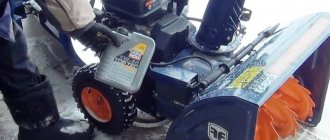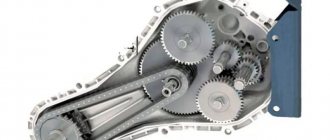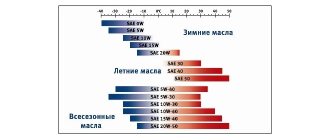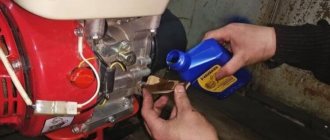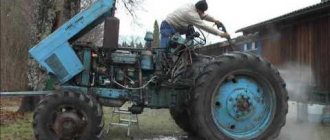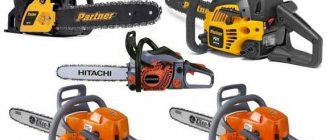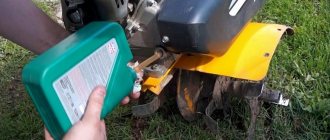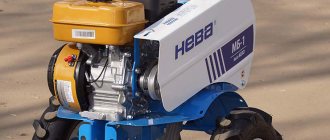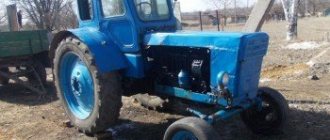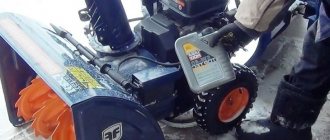How much to fill?
Another important point is the amount of oil needed. Before answering the question - how much oil should be poured into the gearbox of a walk-behind tractor, for example Crosser, Viking, Forza, Sadko, Don, Huter, Profi, Plowman, Champion, Carver, you must first check the oil level in the gearbox. To do this, you need to perform certain actions:
- It is necessary to place the walk-behind tractor on a flat surface so that its wings are strictly parallel to this surface.
- We take a wire or rod about 70 cm long, which will act as an oil dipstick.
- We bend the improvised probe into an arc.
- We insert the resulting dipstick into the filler hole to the very end, i.e. all the way. After that we pull it back out.
If the wire is 30 cm deep in oil, then this is the optimal indicator, i.e. no need to add oil. If it is a little less, then it is necessary to top up within these values.
If the gearbox is completely dry, then you will need at least two liters of gear oil.
Gear oil
Like any other mechanism that has moving parts, the gearbox also requires lubricants. When asked what kind of oil to pour into the gearbox, there are many opinions. Often, owners use transmission oils and special semi-liquid lubricants. These actions may result in a denial of warranty service. Therefore, the best oil for a snow blower gearbox is the one specified by the manufacturer - special gear oil. It does not harm the bronze gear, and also does not change its qualities from low or high temperatures.
Can I use a car?
If it is impossible to purchase special motor oil for a snow blower, experts recommend using automotive fluid that is marked as follows:
- 0W – for temperatures no more than 30 degrees below zero;
- 5W – for temperatures no more than 25 degrees below zero;
- 10W – for temperatures no more than 20 degrees below zero;
- 15W – for temperatures no more than 15 degrees below zero;
- 20 W – for a temperature of no more than 10 degrees below zero.
The engine types of both the snowplow and the car must also match. It is strictly forbidden to use summer car oil in winter. At the first opportunity, experts recommend replacing the car oil in your snow blower with a specialized lubricant.
How to do it yourself
Making your own gearbox involves using various components from other equipment. The fact is that the gearbox itself is a rather complex part, so making it yourself is quite problematic.
Gearbox housing, consisting of two halves
It is impossible to make it yourself, so you need to purchase them separately. Fortunately, the cost of one half of the case is about 700 rubles, which is quite cheap.
Gear
To manufacture them, you will need special metal-cutting equipment, but the optimal solution would also be to purchase ready-made spare parts (see here). For example, the gearbox of a Patriot snow blower, the price of which is about 3 thousand rubles, will be the optimal solution.
Oil seals
They are used as a seal to prevent lubricant from leaking out. They cost about 100 rubles apiece, so purchasing them won’t break your budget.
Bolts
Shear bolts located on the gearbox shaft. They can be made from ordinary bolts by turning grooves using a grinder.
Bearings
Enclosed roller bearings can be used.
For these purposes, a pipe made of grade 45 steel, which is quite resistant to stress, is perfect.
As we can see, most of the components of a homemade gearbox are purchased separately, because There is no technical ability to make them yourself. In any case, self-assembly will cost much less than buying a ready-made gearbox.
Device and application
The torque from the snowblower engine is transmitted to the working system through a V-belt transmission and a power take-off shaft, to which a screw mechanism is connected through a gearbox, as well as a rotor. The gearbox itself is divided into two types:
- Serviced. This type of gearbox must be periodically disassembled to replace the lubricant. Such gearboxes have a longer service life because the lubricant contains bronze components, which partially restore the gearbox gear.
- Maintenance free. Such gearboxes do not require any maintenance, but they are not subject to repair. In the event of a breakdown, the gearbox is removed and a new part is purchased in its place.
As for the gear located inside the gearbox, it is made of soft metals. The main material used is bronze.
This is understandable, because if the auger mechanism jams, it is necessary to prevent damage to the engine, which is the main working unit of the snow blower. The augers themselves are attached to the shaft using shear bolts, which provide initial protection.
In case of any emergency, these bolts are cut off, which avoids damage to the engine. If this does not help, then the gearbox will take the brunt of the blow, protecting the snow blower motor.
Depending on the classification of snow blowers, or more precisely, the scope of their application, the type of gearbox housing also depends. For professional models of snow blowers, which are used to remove snow masses from large areas, the gearbox housing will consist of cast iron.
In turn, household-level models have a gearbox made of an alloy of silicon and aluminum. The body itself consists of two halves, which are connected by bolts.
In addition, gearboxes may differ in their overall dimensions, as well as the size of the gear included in their device. This directly depends on the size of the snow blower bucket - the larger it is, the larger the size of the gearbox itself.
When purchasing, you need to pay attention to this, because snowplows of different power must have different gearboxes. If representatives of the same model range of units have different power, but the same type of gearbox, then they are unlikely to be completely reliable.
Signs of lubricant aging
Gasoline is ideal for removing old grease.
There are several signs that indicate it's time to lure out the grease. These include deterioration of rotation, bearing knocking and rapid overheating of the angle grinder. In this case, if you do not change the lubricant for a long time, the device will quickly fail. To prevent this from happening, you need to monitor the operation of the gearbox and lubricate it on time.
Replacement periods
Many angle grinder owners are interested in how often they need to lubricate the gearbox. It is impossible to determine the exact period, since everything depends on the number of loads. On average, this should be done at least once a year. If the tool is used daily, it should be lubricated every six months.
Removing old grease
There are situations when old grease is difficult to remove. Most often this happens if it has not been changed for a long time. In such cases, you won’t be able to get rid of it with a simple rag. You will have to carefully treat the gearbox with gasoline and kerosene.
Applying a new layer
A new layer must be applied very carefully and carefully. It is necessary to smear it with your hands so that the composition penetrates into all free places. It is necessary to squeeze the mixture out of the tube until its excess begins to flow from the back side of the gearbox.
Required amount
Lubricant must be applied to the entire surface of the gearbox
Some people think that you shouldn't apply too much lubricant, but this is far from true. The fact is that if there is not enough of it, it will dry out faster and the gearbox will begin to work worse. It is necessary to add enough mixture so that each tooth is covered with it.
Monitoring the correctness of the process
After lubrication, you need to check that everything was done correctly. To do this, you will have to start the grinder at idle.
Engine starting
Rice. Starting the engine of a brush cutter ICE domestic mowers are equipped with manual starters. The starter device is simple: a strong cord is wound onto a drum, which is directly or through a gearbox connected to the crankshaft, the start is made by sharply pulling the cord, and the drum unwinds, driving the crankshaft, which in turn starts the engine. More complex models are equipped with an easy-to-start Flash Starter system. This system has a special mainspring, which is twisted through a ratchet by several pulls on the starter cord, accumulating kinetic energy. After which, a special release button is used to release the latch, and the spring unwinds along with the drum and crankshaft. “Easy start” ensures faster start-up and lower energy consumption for the owner. Also, for quick starting, an additional fuel supply to the carburetor is provided with a special button. To supply an additional portion of gasoline, you need to press the button once or twice. The starter gearbox is lubricated with oil intended for lubricating the gearbox.
How to lubricate the gearbox
Any tool with moving elements needs periodic lubrication. Especially if it is actively used. For angle grinders, the consistency and composition of the lubricant must meet certain requirements.
Features of the lubricant:
- absence of solid particles;
- maintaining viscosity at temperatures above 100 degrees;
- good adhesion;
- moisture resistance.
The presence of hard or worse abrasive elements in the composition will cause abrasion of the working surface and individual parts of the device. When a temperature threshold of 100-120⁰C is reached, a cheap lubricant simply evaporates
Therefore, special attention should be paid to the maximum permissible values of the lubricant, otherwise the tool will remain without lubrication in the heat of work
A good composition protects the surface from moisture, as well as from subsequent corrosion, which means it must have water-repellent properties. The adjusted consistency allows you to keep the lubricant on the surface: too thick a lubricant will impede the operation of the mechanism, and a liquid one will simply drain into the gearbox.
The viscosity of power tool lubricants is classified according to the NLGI (National Lubricating Grease Institute) standard. The choice of one or another consistency depends on the specific model of angle grinder, namely, the speed of rotation of the gearbox. The higher this indicator, the less thick the lubricant should be.
Viscosity classification for power tools:
- NLGI 00. The most liquid consistency used in heavy equipment: jackhammers, professional hammer drills, etc.
- NLGI 0. This is a semi-liquid composition, which is precisely used for grinders, as well as circular saws and gasoline scythes.
- NLGI 1. Sufficiently viscous consistency for use in construction hammers and medium-power impact drills.
- NLGI 2. Soft type of lubricant. Used in household jigsaws, light hammer drills and drills.
Engine lubricant requirements
Buying motor oil for a snow blower requires some knowledge. First of all, you should take into account the conditions in which the snow blower operates – cold. Given the fact that snow removal equipment must operate at low temperatures, the oil must meet certain requirements.
- Energy saving - its consumption during heating directly depends on this property.
- Increased lubrication. For high-quality wear protection, the lubricant must be of a certain viscosity, which will ensure rapid penetration into the grooves between the mechanism parts.
- Life time. No one is interested in changing the engine oil frequently, so this criterion should also be taken into account when choosing.
- Versatility. There are oils that are suitable for both diesel and gasoline engines.
An important point when choosing a lubricant is its compatibility with the engine. As a rule, such information is on the packaging. At the same time, different oils are used for diesel and gasoline models.
Self-made mechanism
Often, owners of snow removal equipment equip their units with homemade gearboxes. To make them, you can use improvised and purchased materials. To manufacture the mechanism you will need the following components:
- Housing – in order not to waste time, it is best to buy a ready-made cast iron or aluminum housing from an old gearbox;
- Gear with 20 teeth - it is made of metal using special equipment. You can also purchase a finished part from an old snow blower;
- Oil seals - you can use gaskets made of thick rubber;
- Shear bolts - you can buy fasteners at any store that sells garden equipment;
- Bearings – closed roller bolts can be used to make the gearbox;
- Shaft - to make it you need to take a regular pipe made of grade 45 steel.
Having prepared all the necessary components, you need to carefully study the work plan. The assembly diagram is shown in the figure on the right.
The manufacturing procedure is as follows:
- First, you need to attach the gear and bearings to the shaft;
- Then one of the housing parts is attached to the shaft. In this case, the gear and bearings must be located inside the housing;
- Next, the spare parts are sealed with oil seals, and the second part of the housing is installed on top;
- At the end, both parts of the housing are fixed with shear bolts.
Of course, you will have to spend a little money on making your own gearbox, however, in any case, creating a mechanism will cost much less than buying a new unit.
Gearbox design - studying the mechanism from the inside
The main element of the mechanism is the gear of the snow blower gearbox, made mainly of soft metals. Basically, bronze is used for this. The use of soft metals is explained by the fact that if the auger jams, the engine will not be damaged. The screws are fixed to the shaft using shear bolts, which act as the initial protection of the mechanism.
If emergency repairs are necessary, the bolts must be cut off to protect the snow blower motor. If this does not help, the gearbox of the unit will take the brunt of the blow.
All elements of the gearbox are placed in its housing. If the snow removal unit is used for domestic purposes, the unit body is made of an alloy of aluminum and silicon. In this design, the gearbox housing consists of two parts connected by bolts. In professional equipment, the gearbox housing is made primarily of cast iron.
Depending on the scope of application, the snow blower gearbox can be large or small in size. In large units, the gearbox gear for a snow blower will also have quite large dimensions.
Changing the oil in a snow blower - the correct procedure
Snowblower oil must be changed in a specific order. If the snow blower is just being put into operation, the first change of lubricant must be performed strictly after 5 hours of operation. The second time you will have to change the oil after 25 hours. All subsequent material replacement procedures must be carried out every 50 hours of operation of the unit.
The lubricant replacement algorithm is as follows:
- To begin with, the snow blower must be placed on a flat surface;
- After this, you need to start the unit and wait 5–10 minutes - the heated oil becomes denser and drains faster;
- Next, you need to turn off the engine and unscrew the plug at the bottom of the oil tank;
- After this, you need to remove the cap and dipstick from the neck;
- Then you should completely drain the oil from the tank, placing a container under it;
- Next, you need to tighten the drain plug and fill in fresh oil;
- At the end, all that remains is to screw in the dipstick and cap and continue operating the snow blower.
After changing the oil, you need to start the unit’s engine and let it run for about 1–2 minutes. Next, you need to turn off the engine and check the oil level in the tank.
Technical characteristics of popular models
PS 550 d
Snow blower Patriot PS 550 d - a model with a manual engine starting system, thanks to a serrated auger, is used for clearing small and medium-sized areas not only of snow, but also ice.
The snow mass is thrown in the selected direction at a distance of up to 10 meters, and the width of one passage is 56 centimeters.
| Characteristic | Meaning |
| Engine | 4 measures |
| Power | 5 horsepower |
| Working width | 56 centimeters |
| Unit height | 51 |
| Screw system | 2 steps |
| Screw material | Metal |
| Self-propelled gun | Yes |
| Forward-backward speed | 5 – 2 |
| Engine Manufacturer | PatrioT |
| Fuel tank capacity | 3.5 liters |
| Way to travel | On wheels |
| Blowout | Up to 10 meters |
| Rotate the chute | 190 degrees |
| Starter type | Manual |
| Mains power | No |
| headlight | No |
| Battery powered | No |
| Package | 98*63*79 |
| Weight | 73 kilograms |
| Price | RUB 24,990 |
You will see more detailed information about Patriot snow blowers in the videos below:
PS 551d
The Patriot snowplow with the PS 551 d modification is a powerful piece of equipment that can cope with the removal of wet compacted snow. Equipped with a four-stroke engine, a reliable bucket, large maneuverable wheels and a wide range of driving intensity.
| Characteristic | Meaning |
| Engine | Petrol |
| Power | 4050 W |
| Working width | 55 centimeters |
| Unit height | 51 |
| Adjustment of throw direction | Yes |
| Selecting the snow mass throw range | Yes |
| Main mechanism | Metal screw |
| Self-propelled gun | Yes |
| Forward-backward speed | 5 – 2 |
| Way to travel | On wheels |
| Blowout | Up to 14 meters |
| Starter type | Manual |
| D wheels | 34 cm |
| Weight | 66 kilograms |
| Price | RUB 21,500 |
PRO 650
The snowplow Champion, Honda, Foreman, MTD, Huter, Craftsman, Pro 650 is very popular among buyers. The device is distinguished by convenient functionality and high performance; it easily copes with both loose and compacted snow.
Thanks to the one-wheel locking function, it has excellent mobility and can be successfully deployed even in a narrow area.
Technical parameters of PRO 650:
| Engine | Lonchin |
| Power | 6.5 l. With. |
| Fuel tank capacity | 2.8 liters |
| Ladle | 51 cm |
| Adjustment of throw direction | Mechanical |
| Selecting the snow mass throw range | Mechanical |
| headlight | – |
| Heated grips | – |
| Speed forward-reverse | 5 – 2 |
| Way to travel | On wheels |
| Blowout | Up to 13 meters |
| Starter type | Manual |
| Gearbox | Aluminum |
| Snowdrift Buster | – |
| D wheels | 30 centimeters |
| Motherland | America |
| Assembly | China |
| Guarantee | 3 |
| Weight | 75 kilograms |
| Price | RUB 38,990 |
Gasoline and fuel consumption
In order to understand which snow blower to choose, it is important to know its fuel consumption. It's worth noting that there are no specific meanings here. Consumption varies depending on engine power, area and topography of the treated area, height and density of snow, and the presence of ice. Ideally, the engine is 5.5 hp. consumes about 1 liter per hour of operation, models from 7 hp. spend about 2.5 liters. On average, this value is equal to 1.5-2 liters. The standard capacity of a gasoline tank is from 1.8 to 3 liters. Thus, on one refill the device can operate for 1.5 – 2 hours.
The best option for refueling a snow blower is gasoline with an octane rating of 92, in some cases 95 is used. Gasoline should be poured into the snow blower from a clean container. For a two-stroke engine, it is important to get the mixture right.
Advice! Before adding gasoline, you need to shake it. In addition, do not fill the container above the special mark.
General rules for replacing lubricant
The main module of an angle grinder is the gearbox. It is this part of the grinder that experiences the maximum load. The block includes various elements that promote rotation. Getting into the tool body, the substance reduces friction. The compositions used for the angle grinder gearbox make it possible to reduce the temperature indicators that arise during operation.
During operation of the grinder, the lubricating mixture placed inside gradually scatters within the body. After a while, the substance begins to dry out, and lumps form during the work. These pieces collect particles of dust and metal, which is why a quick replacement of the oily composition is necessary. Sometimes the problem occurs due to high temperature. The lubricant heats up, leaks out, and the gearbox is left without a protective mass
It is important to replace it in a timely manner
How to properly remove old grease from an angle grinder
The disassembled grinding machine mechanism must be thoroughly cleaned of old oil. It no longer performs its function, plus particulate matter has already accumulated in it due to wear and tear on the moving parts. When mixed with a new or old lubricant, its characteristics also deteriorate significantly. Therefore, the gearbox and gearboxes must be thoroughly cleaned.
Remove old oil from gearbox
Old grease is removed with a rag, paper towel or just a rag. Removed parts can also be washed with gasoline or thinner. Washed parts should be thoroughly dried before installation. Remaining solvent or gasoline will mix with the new oil and change its consistency, again degrading its performance.
Two-stroke and four-stroke engines
Internal combustion engines are divided into two types:
One stroke is the movement of the piston up or down. One revolution of the shaft requires two strokes. Engines in which one shaft revolution occurs per operating cycle are called two-stroke. Models with two revolutions are four-stroke. The differences between these engines lie not only in design, but also in some other indicators. In particular, there is a difference in the method of lubrication.
In a two-stroke engine, lubrication is carried out using a mixture obtained by combining oil and gasoline in a ratio of 1:25 or 1:50. The mixture circulates in the system and lubricates all necessary components. After it ignites, the oil is eliminated in the form of combustion products. There are two ways to get the mixture. In the first case, this is carried out directly by the operator, that is, a ready-made version is uploaded. In the second, the technology does everything itself. In this case, the engine is equipped with a special oil tank, from which, using a pump, oil in a strictly specified amount enters the nozzle, where mixing is carried out.
Four-stroke engines do not require mixture. Oil and fuel enter the system separately. In this case, the engine has a special lubrication system, which includes a pump, filters, valve and oil supply line.
Due to the fact that two-stroke engines burn oil, but 4-stroke engines do not, the oil requirements for both systems differ. In the first case, it must produce as few products as possible during combustion, in the second, it must maintain its characteristics for a long time.
Snow blower gear lubrication
Stable operation of the unit depends on many factors, the main one of which is high-quality lubrication. The oil used to service the snow blower mechanism must have the following properties:
- frost resistance - since the snow blower is used at extremely low temperatures, the lubricant for its gearbox must retain its structure under constant exposure to frost;
- high fluidity - the oil must quickly penetrate into the smallest grooves and holes, thereby ensuring continuous lubrication of rubbing parts;
- viscosity - the working fluid must be thick enough to cover the working parts of the unit with a durable, homogeneous oily film.
Replacing used lubricant in a mechanism that has lost its properties is quite simple.
To do this you need to act in this order:
- First you need to remove the screws and remove the casing;
- After this, the operator will need to unscrew the bolts located directly behind the “snail”;
- Then you need to carefully remove the factory auger belt installed on the factory pulley;
- Next, you need to unscrew the bolts one by one, which firmly secure the shaft of the built-in auger;
- After this, you need to carefully turn the “snail”, and also remove the auger and the impeller installed on it;
- Then you will need to unscrew the standard shear bolts and completely disassemble the mechanism shaft;
- In the end, the operator will have to completely disassemble the built-in gearbox itself.
https://youtube.com/watch?v=ptYGBLcnVA4
After this, you will need to thoroughly rinse the mechanism parts. The operator can then reassemble the factory snow blower gearbox and apply new lubricant.
How to quickly remove the gearbox
To perform a scheduled lubricant change, the gearbox must be removed from the snow blower. The algorithm for this process consists of several simple operations.
- Place the snow blower level and stationary.
- Remove the plastic protection from the belts and the auger cable that goes to the drive.
- Unscrew the screws located behind the “snail” (round body) for throwing out snow.
- Remove the belt that goes from the pulley to the auger. You should carefully pry it off with a screwdriver.
- Unscrew the screws securing the auger shaft.
- Turn the snail so that it is in its normal position until it clicks. Carefully remove the auger mechanism and impeller.
- Remove the shear bolts from the auger and remove the shaft.
Greases for friction pairs plastic-metal (P-M) and plastic-plastic (P-P)
A mandatory requirement for lubricants for plastic gears is compatibility with plastics.
Special EFELE greases do not destroy gear parts, are capable of operating in a wide range of temperatures and loads, have high adhesion and do not drain from gear teeth, improving the lubrication of gear teeth at the time of start-up after a long stop.
Synthetic (PAO) frost-resistant multi-purpose greases EFELE SG - 311 (-60...+120 °C), EFELE SG - 391 (-40...+160 °C), EFELE SG - 394 (-20...+260 °C) are suitable for friction pairs “plastic-metal” and “plastic-plastic”.
Drive motors
Most mowers are equipped with a gasoline engine (ICE), it can be two-stroke or four-stroke, there is no particular difference between them. The four-stroke is more economical and powerful, but more difficult to maintain and more expensive to repair. The two-stroke is easier to maintain, cheaper, but low-power, consumes more fuel, and has a dirtier and noisier exhaust. There are also combined engines. In addition to gasoline engines, trimmers can be equipped with electric motors that are connected to a 220V household network with a long cable, but, as a rule, these are household devices that are connected to the power supply wires.
Causes of malfunctions and repairs
Many experts advise choosing snow blowers that use a serviceable gearbox. Of course, it requires some handling, but it will last much longer than a maintenance-free gearbox.
However, this issue also has a second side - such gearboxes tend to break at the most inopportune moment. Using the example of Patriot, Tselina, Champion and Profi snow blowers, let's look at what gearbox failures can happen, as well as methods for eliminating them.
- There are sharp knocking noises in the gearbox of a Champion snow blower - the most likely cause of this problem is damage to the worm turns or bearings. The way out of the situation would be to adjust or replace the bearings, as well as purchase a new worm pair.
- If you observe that the Patriot snow blower gearbox is overheating, then several factors may be causing this phenomenon. In particular, the issue may be due to insufficient lubrication or wear of the bearings.
- In the first case, you simply need to add the required amount of lubricant, and in the second, adjust the bearings or replace them with new ones.
- If the gearbox of a Profi snow blower vibrates very strongly, then the likely cause may be misalignment of the shafts and the engine of the unit. Thus, do-it-yourself repair of the Profi snow blower gearbox is carried out by eliminating this misalignment.
- If grease leaks from the Tselina snow blower gearbox, the likely cause may be a clogged drain hole in the vent. To correct this situation, you need to rinse the vent plug in kerosene and then wipe it dry.
- Another common cause is wear of the gear included in the gearbox design. This is understandable, because it is made mainly of bronze, so during long-term use, its edges can simply wear off.
- The only way out of this situation is to completely replace the gear with a new one.
In most cases, snowplow gearboxes can be repaired without requiring replacement. Of course, you may need to purchase individual gearbox components - oil seal, gear, etc. However, this is not such a big expense as in the case of purchasing the entire gearbox.
By the way, the cost of components may vary. For example, a 24 tooth snow blower auger gear will cost about 3 thousand rubles. By the way, gears of different types of gearboxes may have a different number of edges - basically, these are 20 teeth and 24 teeth, depending on the model of the snowblower.
For more information about gearbox repair, watch the video:
Device and application
The torque from the snowblower engine is transmitted to the working system through a V-belt transmission and a power take-off shaft, to which a screw mechanism is connected through a gearbox, as well as a rotor. The gearbox itself is divided into two types:
- Serviced. This type of gearbox must be periodically disassembled to replace the lubricant. Such gearboxes have a longer service life because the lubricant contains bronze components, which partially restore the gearbox gear.
- Maintenance free. Such gearboxes do not require any maintenance, but they are not subject to repair. In the event of a breakdown, the gearbox is removed and a new part is purchased in its place.
As for the gear located inside the gearbox, it is made of soft metals. The main material used is bronze.
This is understandable, because if the auger mechanism jams, it is necessary to prevent damage to the engine, which is the main working unit of the snow blower. The augers themselves are attached to the shaft using shear bolts, which provide initial protection.
In case of any emergency, these bolts are cut off, which avoids damage to the engine. If this does not help, then the gearbox will take the brunt of the blow, protecting the snow blower motor.
Depending on the classification of snow blowers, or more precisely, the scope of their application, the type of gearbox housing also depends. For professional models of snow blowers, which are used to remove snow masses from large areas, the gearbox housing will consist of cast iron.
In turn, household-level models have a gearbox made of an alloy of silicon and aluminum. The body itself consists of two halves, which are connected by bolts.
In addition, gearboxes may differ in their overall dimensions, as well as the size of the gear included in their device. This directly depends on the size of the snow blower bucket - the larger it is, the larger the size of the gearbox itself.
When purchasing, you need to pay attention to this, because snowplows of different power must have different gearboxes. If representatives of the same model range of units have different power, but the same type of gearbox, then they are unlikely to be completely reliable.
Characteristics and features of lubricants for angle grinders
When servicing any hand tool with moving parts, a lubricant is used that has the following characteristics and features:
- It should not contain solid particles that could cause chipping of the moving parts of the mechanism.
- The temperature at which the lubricant becomes liquid must be more than 120 degrees.
- The oil should not absorb moisture and should form a durable film that protects parts from corrosion.
- And also, most importantly, the oil must be of such viscosity that it is able to adhere to moving parts.
The consistency or viscosity of lubricants is classified according to the NLGI (National Lubricating Grease Institute), and in certain cases it is necessary to use oil of a certain thickness. The viscosity of the oil is selected depending on the speed of the gearbox; the higher it is, the thinner the oil should be. So, depending on the tool, the viscosity is selected:
- Drills, hammer drills, jigsaws, where the gearbox has a low rotation speed. Lubricant with index NLGI-2 which is soft.
- Lightweight rotary hammers and impact drills. Class NLGI-1, very soft consistency.
- Angle grinders, circular saws, brush cutters. Class NLGI-0, semi-liquid consistency.
- Heavy hammer drills, jackhammers. Class NLGI-00, consistency is liquid.
Recommendations for selection
In specialized stores you can see several types of snow blower oil, which have a number of individual characteristics. Experts recommend the following brands of oils.
- M - 82k is a mineral type of lubricant that has a wide range of applications. The added additives not only significantly increase the period before changing the oil, but also has a maximum pour point of more than 30 degrees above zero. Can be used for diesel engines.
- M - 8 M is a mineral liquid that is used for equipment in different countries of the world. Advantages - high anti-corrosion performance, resistance to low temperatures, long-term operation, used in gasoline and diesel mechanisms.
- MT – 16r – oil for diesel vehicles. Advantages – protection of parts from corrosion, oxidation and wear.
Particular attention should be paid to universal lubricants.
- RAVENOL Schneefraese 4-Takt 5W-30 is a German artificial 4-stroke product. Advantages: slow evaporation, low consumption and oxidation, can be used without preheating the engine.
- Oregon SAE 30 is an American semi-synthetic product for gasoline vehicles. Advantages - high level of purification, low percentage of consumption.
- MTD SAE 5W-30 is a German mineral 4-stroke product. Advantages - efficiency, use in a cold engine, protection of the engine from wear and corrosion.
- Craftsman SAE 5W-30 is a domestic mineral product that is used for gasoline and diesel vehicles to significantly reduce noise levels and protect all parts from oxidation, rapid wear and corrosion.
Before purchasing, it is better to consult with experienced owners of this equipment.
Checking the correct application of lubricant to the angle grinder gearbox
The last step in servicing an angle grinder is to check that the lubricant is applied and distributed correctly inside the gearbox. For this purpose, if the gear unit is assembled, turn on the power tool without load for several minutes, while keeping an eye on it to avoid any extraneous sounds, smells, etc. If they occur, you must immediately disconnect the angle grinder from the network. The heating of the gear unit is also checked. The lubricant must distribute heat evenly and the temperature of the gear unit should not be very high.
After some work, unscrew the 4 screws and then remove the cover from the gearbox. The helical gears should be visually inspected for the presence of lubricant. If it is missing, it means that a very small amount of lubricant was used and should be reported. If during work it is squeezed out of the cracks, it means that there is a lot of it and the excess should be removed. After making any changes, check the operation of the angle grinder again without load.
Lubricant for famous brands of trimmers
Any brand that manufactures gasoline trimmers always recommends lubricant for the lawnmower gearbox directly from its own production.
Husqvarna. } myth The Swedish manufacturer recommends using Multi-Purpose Grease Grasa Universal. This material is available in blue-black tubes with a volume of 225 or, in other words, 250 g
According to the company, this trimmer gear lubricant is designed specifically for Husqvarna equipment, taking into account the steels used and operating speeds. Stihl. For Stihl FS series lawn mowers, the manufacturer recommends using Stihl Superlub FS gear lubricant, available in 225 g tubes or 80 g disposable containers in silver-orange color. Patriot
It is recommended to service the gearboxes of this brand of lawn mowers with Arsenal's unique AR-417 lithium grease. It is specially designed for gear reduction gears operating at high speeds and temperatures. Huter. For the bevel gear of the tool models of this Huter company, any of the above brands of gear lubricants are used, also universal ones such as Rezoil, CIATIM and others. Champion. The recommended lubricants in the Champion walk-behind trimmer owner's manual include CHAMPION Super-Lube EP-O. The material is supplied in a 250 g jar or in a disposable oil can Premium Champion C1104. Makita. This is a common rumor that the Japanese manufacturer advises its consumers to use Makita branded lubricant, which comes in white tubes with a red cap of 65 ml and 80 ml.
Factors for choosing a brush cutter gearbox lubricant
Often, the owner of a certain brand of gasoline trimmer cannot, for whatever reason, purchase the lubricant recommended by the manufacturer. In this option, it will be necessary to search for an analogue, which in its properties will be identical to the branded paste
Therefore, when choosing pastes for your lawn mower gearbox, you need to know the following prerequisites:
Lawnmower gearbox lubrication
- Lubricant viscosity. Our client remains exposed to the current sector of the market, the pastes are divided into three main groups, speaking directly: high-viscosity (contain additives), solid lubricants (soften during operation of the unit) and universal plastic compounds.
- Lubricant consumption rate. This factor is taken into account from the characteristics of the wearer’s personal experience, and is characterized by the period between two lubrications. Most manufacturers require the gearbox to be serviced for 20-40 hours of operation.
- Degree of adhesion to gearbox parts. } myth indicator is characterized by the adhesion of grease to the steel trimmer assembly.
Which hammer drill components need to be lubricated?
According to the operating instructions, the hammer drill requires lubrication in three zones. This will extend the life of the device and equipment, and facilitate the operation of the tool. Let's figure out what exactly needs lubrication and why.
Working equipment
Working equipment (drills and bits) inserted into the chuck are subject to enormous load. They receive from 1000 to 5000 blows per minute, transmitted to solid material, thanks to which the tool easily passes stone, concrete screed, brick and other obstacles.
The operating instructions instruct you to lubricate the drill shank before each use. If the hammer drill is operated during the day, the operator is required to periodically remove the drill and check the presence of lubricant on the shank. Without lubrication, the assembly will quickly overheat and break, which will require not only the purchase of new equipment, but also repair of the cartridge.
Lubricant for hammer drills is applied to the grooves (two or five, depending on the type), which are secured with locking wedges. You must first wipe the outside with a napkin to remove any remaining dust and dirt. The product is usually squeezed out of a tube. 1 g is enough for uniform application. When changing drills, bits and other equipment, lubrication must be done each time. After removing the drill or other device, the end should be wiped with a napkin so that it does not stain the suitcase and surrounding objects during storage.
Correct application of lubricant to the hammer drill.
Lubricant for drills reduces friction in the fixation system and extends the life of the drill shank (if this section “sticks together”, then even with an intact punching part with a Pobedit nozzle, the equipment will not be suitable for work). Hammer drill lubricant also protects against dust penetration, trapping it on itself. Small particles of crushed walls and other debris do not penetrate into the instrument.
Watch a video about lubrication of hammer drills:
Cartridge
When you buy a new hammer drill, its chuck is dry. The user needs to lubricate the entry point of the tool, since this is where the greatest friction occurs. This action will protect the assembly from excessive wear and dust penetration.
Gearbox
This unit is responsible for transmitting torque from the electric motor to the cartridge. Internal parts here are subject to increased friction when operating at high speeds and elevated temperatures. The mechanism also gradually becomes clogged with debris, dust and dirt. To reduce wear, manufacturers supply it with a special coating, but this is not enough for everyday work, so after a long period of operation it is necessary to disassemble the housing and apply lubricant to the gearbox. If you do not know how to do this, then the tool must be taken to a service center, where a specialist will perform this work.
The gearbox can be of two types:
1. With separate execution from the shock group. Here the reciprocating mechanism for making strikes is made separately. It consists of a crankshaft and a piston group that create a force transmitted to the cartridge. The system has its own lubrication. The gearbox is only responsible for the rotation of the equipment.
Rotary hammer gearbox with separate design from the shock group.
2. With a single ratchet-type implementation. In this case, the gearbox also includes the impact mechanism itself (“drunk bearing”). The lubricant for the hammer drill gearbox and impact unit is common here and is applied by the operator according to a schedule, depending on the frequency of operation of the device.
Gearbox together with impact mechanism.
The gearbox itself consists of two gears. They can have straight or oblique teeth. The latter are designed for increased load.
There is a new type of gearbox with a planetary gear that includes more than two gears. Thanks to this mechanism, you can change the gear ratio - the engine rotor rotates quickly, and the cartridge rotates slowly. This gives increased power (rotation force) at a low number of revolutions. The equipment heats up less, but does not jam, and confidently drills into hard material.
Planetary reductor.
In a ratchet mechanism, in addition to the friction of gears against each other, longitudinal movement is also carried out. The small gear is equipped with a moving mechanism that moves back and forth up to 2000-4000 times per minute. This entire mechanism must be sufficiently lubricated, otherwise the unit will quickly wear out and become loose.
The shafts themselves are also installed in bearings, which can have their own lubricant (closed bearings) or common with the gearbox (open bearings). Without proper lubrication, the balls in them will wear out, which will lead to play and wobble of the chuck, as well as increased noise when operating the hammer drill.
Watch a video about lubrication of a rotary hammer gearbox:
Types of gearboxes
Gearboxes in snow blowers are of the following types.
- Serviced. You can disassemble it yourself to add lubricant or replace worn parts. The elements of this mechanism are made of bronze, which explains their slow wear. This type of gearbox is rated as more reliable - it can work for a very long time with proper care. This is the mechanism used in European, Japanese and American models of snow blowers.
- Maintenance free. This gearbox requires no maintenance, but cannot be disassembled or repaired. The period of use of such mechanisms is limited. If the gearbox is broken, you should buy and install a new one. There are no other options here. Inexpensive Chinese and Korean models are equipped with this type of gearbox.
Types of gearboxes in snowblowers
The torque of the snow removal unit created by the motor is transmitted to the working parts using a power take-off shaft and a V-belt drive. A gearbox located near the machine engine is attached to the shaft via a screw mechanism. In this case, snow removal equipment can be equipped with two types of gearboxes:
- Serviceable gearboxes - mechanisms of this type require periodic disassembly for partial or complete maintenance. Such elements have a longer service life; their components are made of bronze, due to which the gear of the snow blower gearbox is much less susceptible to wear;
- Maintenance-free gearboxes - such units do not require maintenance, but at the same time they cannot be repaired. In case of any malfunction, the mechanism must be removed and thrown away, and a new part installed in its place.
Gearboxes of the second type are equipped with cheaper models of snowplows - units made in China and Korea. Mechanisms of the first type are used in equipment of European, Japanese and American brands.
The process of cleaning and lubricating the gearbox
After removing the gearbox and dividing its housing into two halves, all the insides should be thoroughly washed to remove old grease. To do this, it is best to use gasoline, which will quickly clean the gearbox. It is worth noting that for proper operation of the gearbox, you need to use only the oil specified by the manufacturer in the instructions. The wrong lubricant can damage the entire device and damage the mechanism.
After the cleaning process, you should proceed to lubricating the insides of the gearbox. To do this, unscrew the special fitting and pump the required amount of lubricant into the hole using a regular syringe. Next, you should screw the fitting back and assemble the gearbox, and then install it back on the snow blower
It is important to remember that gearbox maintenance should be done at the end of each season.
Tips for use
To increase the service life of the snow blower gearbox, you should carefully read the advice of experienced professionals.
- Always use only high-quality gear oil for lubrication. If you lubricate the device with semi-synthetic analogues, the mechanism will quickly fail.
- Take ten-minute breaks after the snow blower has been running for an hour. This is necessary to ensure that the gearbox does not heat up too much and does not wear out prematurely.
- Clean the assembly regularly. Even when pouring high-quality oil, carbon deposits can accumulate on the walls, interfering with the ideal operation of the mechanism. If you use your snow blower regularly, you should wash it every two weeks.
Changing the oil in a snow blower
Changing your snowblower oil is easy enough to do yourself. This is best done in a dry room at a temperature of 10 to 15 ⁰C. There should be no dust in the selected room, as it can get into the oil and, in the future, damage the rubbing elements of the snow blower.
Changing the oil on a snow blower is carried out in the following order:
- First, the utility vehicle you are using must be driven into the garage and placed motionless on a flat surface;
- Then you need to start the snow blower engine and let it idle for about 10 minutes. During this time, the motor fluid will heat up and acquire the desired working consistency;
- After this, you will need to turn off the internal combustion engine of the snow blower and place an old wide container under the drain hole of the oil tank;
- Next you will need to start slowly unscrewing the oil tank cap. Old working fluid will begin to flow out of it. You need to be careful as the drained material will be quite hot;
- Once all the used product has been drained from the snow blower tank, the drain cap will need to be screwed on tightly;
- Then you need to fill in new oil, for example, 5W30, after unscrewing the filler cap;
- The marks on the oil filler dipstick will tell you how much oil is required for normal operation of the snow blower.
After replacing the lubricant, you will need to start the snow blower engine and let it idle for about 2-3 minutes. After this time, you must turn off the car engine and check the oil level on the dipstick. If necessary, lubricant must be added.
Maintenance
It is not difficult to carry out maintenance of a snow blower; you just need to be careful and follow all the necessary rules:
- Use protective equipment and do not forget to check that it is functioning properly.
- Before starting maintenance work, always stop the engine and remove all controls from the operating position and disconnect the ignition cord.
- Carry out an external inspection of the unit, make sure that all bolts and nuts are securely fastened.
- Ensure that all engine stroke settings are maintained.
- When replacing faulty mechanisms, use only spare parts recommended by the manufacturer.
- Ensure that all machine controls are functioning properly.
- After finishing work, the engine needs some time to cool down.
- To prevent premature wear of the snow blower mechanisms, promptly carry out maintenance work recommended by the manufacturer.
Fuel
- Fill the tank with fuel only with the engine off and outdoors.
- Follow safety precautions when refueling: place the machine away from flammable objects, do not smoke.
- Before the first refueling, remove the special cap, and after filling the tank, install the cap;
- To prevent gasoline from spilling, always use a funnel;
- Do not fill the tank to the brim, leave about 1.5 cm for the expansion of fuel particles;
- For refueling, use AI-92 gasoline.
How to change oil
- Place the snow blower on a hard surface.
- We take out the dipstick and unscrew the drain bolt.
- We wait until all the used oil is poured into a pre-prepared container.
- Screw the drain bolt into place.
- Pour new oil through the filler hole.
- Using a dipstick, we check whether the required level is met.
- Install the dipstick into the drain hole.
How to lubricate bearings
At least once a year it is necessary to carry out work to lubricate the rubbing mechanisms: the shaft and bearings of the auger. To lubricate the auger shaft, remove the shear bolts from the shaft. Shaft lubrication points are located at both ends of the shaft.
Signs of common problems
Knowing the internal structure of the lawn mower and the principle of its operation, you can easily troubleshoot problems with your own hands. Some breakdowns occur most often and are identified as the main ones.
Engine malfunctions should be looked for if the brush cutter does not work or does not even start
It is also worth paying attention to this part of the scythe if you hear unusual noises or feel strong vibration during operation. A clogged air filter can also lead to engine problems. If fuel does not enter the combustion chamber, then the cause should be a clogged fuel filter.
It is also worth looking at it if the tool does not work at low speeds
If fuel does not enter the combustion chamber, then the cause should be a clogged fuel filter. It is also worth looking at it if the tool does not work at low speeds.
No spark. This often happens if fuel floods the spark plug.
The brush bar of the brush cutter vibrates a lot, which makes working with it more difficult.
The gearbox heats up excessively in a short time, which is felt during operation of the scythe.
At low speeds, the line spins weakly, which affects performance.
The starter grid is clogged - the reason for the engine to overheat and stop working. The starter can also fail when the cord breaks when started too hard.
A clogged carburetor may be due to the use of low-quality fuel.
It is also important to pay attention to the carburetor in time if the mixture is leaking
The lawn mower stalls after turning off if the carburetor is not configured correctly.
Malfunction - The knife and reel do not rotate.
Cause - Wear of transmission elements.
The transmission of these lawn mowers consists of a lower gearbox, a shaft and an upper gearbox (cup). Let's take a closer look at them.
Lower gearbox.
The gearbox consists of a housing and a gear pair, which are subject to wear.
This happens due to the lack of lubrication in the gearbox.
Do not neglect this procedure while using the lawn mower.
Lubrication control will extend the life of the gearbox.
There are sets of gears for these gearboxes on sale, but their cost exceeds 60-70% of the cost of the gearbox, and the process of replacing them is labor-intensive; a simple solution would be to replace the gearbox with a new one.
Drive shaft and rod
The transmission of traction from the engine to the gearbox is ensured by a rigid shaft, at the end of which there are splines. Due to lack of lubrication in the gearbox, the splines may wear out. In this situation, only replacing the shaft with a new one will help.
Please note that there are 3 types of shafts (7 splines, 9 splines and “square”). The shaft length, as a rule, on such models is 152mm. Replacement is very simple - dismantle the old shaft and install a new one
Replacement is very simple - dismantle the old shaft and install a new one.
Upper gearbox
The upper gearbox has a clutch cup, which has splines for the shaft.
If they wear out, they will need to be replaced.
The cup can be replaced either separately or the entire upper gearbox.
To remove the cup, you need to remove the locking ring (item 49), catching its “ears” in the holes of the cup (item 48).
Please note that the cup also has shaft options (7 splines, 9 splines and “square”)
Gasoline trimmer clutch
The blade or reel rotates at idle (provided that the carburetor settings are correct)
If such a malfunction occurs, you will need to replace the clutch spring or the clutch assembly.
Clutch replacement:
To replace the clutch, you need to unscrew the upper transmission gearbox. Next, unscrew the spark plug and stop the piston movement with a special stopper. We unscrew the 2 screws securing the clutch (item 57) with washers (item 56), remove the clutch assembly and the washers under it (item 53). We change the spring on the clutch, or install a new one. Don’t forget to install the washers (item 53), then the clutch, and tighten the bolts (item 57) with special engraving washers (item 56).
Preserving a snow blower for the summer
If you want to have no problems with starting at the beginning of the season and the snow blower to serve you without breakdowns for many years, you need to carry out the necessary procedures presented below after the end of the winter season.
To carry out conservation you will need:
2. Clean, dry cloth (preferably not needed :).
3. Grease - lithium (litol) and graphite (optional).
4. Oil SAE 5w30, or SAE 0w30.
5. A syringe for filling in grease (if your snow blower is equipped with special grease nipples). See paragraphs 6 and 8.
6. Liquid lubricant sae 75w90 (if your snow blower is equipped with a gearbox with liquid lubricant). See paragraph 7.
7. Well, half an hour is an hour of free time.
All lubricants and accessories are readily available at auto parts stores.
1. Rinse the snow blower body with a stream of water from a hose. It is not recommended to use high-pressure washers when washing a snow blower, as sand particles and other abrasives can get inside the bearings under pressure, which will accelerate their wear. Don't forget to clean the inside of the auger. Allow the water to drain, then wipe the housing with a clean cloth.
2. If you want the snow blower to serve for a long time, you need to treat chips and scratches with anti-rust agents for summer storage.
3. The shelf life of fuel, during which its qualities are preserved, is 30 days. And using gasoline after this period may damage the carburetor and/or fuel system. Whatever happens, you need to drain all remaining gasoline or use a fuel stabilizer to extend the life of gasoline.
To drain gasoline, you need to disconnect the fuel hose at the point where it connects to the carburetor. Use a funnel to avoid fuel leakage.
Please note that there is some gasoline left in the float chamber and it must be removed as well. Some snow blowers have a drain bolt in the carburetor located near the center float bowl mounting bolt. If it is not there, then you can drain the gasoline from the carburetor by unscrewing the central bolt of the float chamber, or start the snow blower and let it stall after using up all the remaining gasoline in the float chamber.
4. The oil needs to be changed. Use oils marked SAE 5w30, or SAE 0w30.
5. To prevent corrosion of the combustion chamber, it is necessary to unscrew the spark plug and pour a teaspoon of oil into the chamber. Then, pull the starter handle several times, without jerking, so that the oil is evenly distributed in the chamber. Afterwards, you need to pull the starter rope until resistance appears so that the valves close, this will additionally protect the combustion chamber from corrosion.
6. It is necessary to lubricate the auger drive shaft, this will protect it from rust, which in the future can lead to serious damage to the gearbox or augers.
Some snow blowers are equipped with special grease nipples for injecting the inner surface of the augers. It is necessary to fill the auger with lubricant using a special syringe. We recommend using lithium grease (Lithol), which is readily available at most auto parts stores.
If your augers are not equipped with grease nipples, then lubricant can be applied to the holes of the shear bolts (pins) by first unscrewing them. And in the gaps between the augers. After applying the lubricant, you need to rotate the screw on the shaft several times. Repeat this procedure several times. You can use lithium or graphite grease. When using graphite lubricant, try to ensure that it does not get into moving parts (bearings, shaft bushings), this can lead to increased friction of these components.
7. It is also necessary to lubricate the place where the ejection chute is attached to the auger body.
8. Maintenance of the snow blower gearbox. Check the oil in the auger gearbox. There are two types of lubrication in gearboxes: Grease (thick) lubrication and Liquid lubrication. You can determine what type of gearbox a snow blower is equipped with by the presence of a filler bolt or an oiler for injection.
If you have an oiler in the gearbox, then you need to add the required amount of thick grease with a syringe. Typically, lithium grease (litol) or its more frost-resistant analogues are used.
If you have a bolt at the end of the gearbox, then by unscrewing it, you can check the oil level. The filler hole is also a level indicator; oil must be poured into the thread. If there is not enough oil, then it is necessary to completely replace it. It is necessary to use grease marked SAE75w90; it is more frost-resistant and ensures sufficient lubrication of the worm gear in winter. Check for drips and traces of oil in the lower part of the gearbox.9. For further work, it is necessary to place the snow blower in the maintenance position - See figure.
Next, you need to open the back cover (pan) of the snow blower body; as a rule, it is secured with 2-4 bolts.
It is necessary to lubricate the hexagonal shaft of the friction disc with grease (lithol, graphite). When lubricating, pay attention that the amount of oil should be minimal; it is better to wipe this shaft with an oily rag, otherwise the oil may get on the drive disk and there will be no clutch with the friction disk. We also lubricate the self-propelled drive gears with grease. If your snow blower is equipped with a chain drive, then it must be lubricated with liquid oil (engine oil is quite suitable).10. Check all snow blower drive cables, if they have a double device (core and braid. See figure), then you need to lubricate the cable core with liquid oil (motor oil is fine).
11. If your snow blower is equipped with a rechargeable battery, the battery must be fully charged to prolong its service life.
12. The ideal temperature for storing a snow blower in summer is room temperature. But if you do not have this opportunity, then you should store the snow blower in a dry, well-ventilated place in the summer.
If you followed all the points during conservation, then your winter assistant will serve for many years without breakdowns and at the beginning of the season there will be no problems with starting.
